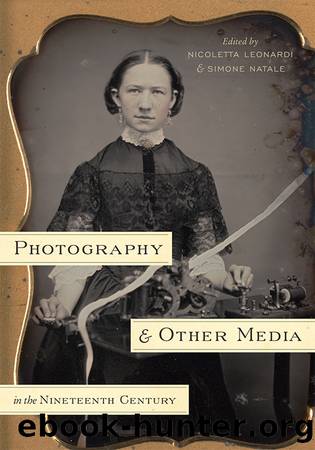Photography and Other Media in the Nineteenth Century by Leonardi Nicoletta;Natale Simone;

Author:Leonardi, Nicoletta;Natale, Simone;
Language: eng
Format: epub
Publisher: Pennsylvania State University Press
An Extension of the Graphic Arts: Lereboursâs Excursions daguerriennes
As the daguerreotype became a public matter in August 1839, the optician Noël Marie Paymal Lerebours was among the first businessmen to seize the opportunity. The store opened by his adoptive father, Noël Jean Lerebours, in 1789 at Place du Pont-Neuf had long been among the key Parisian addresses for the production and distribution of optical instruments. In June 1839, only weeks before the publication of his photographic procedure, Daguerre signed a contract with another Parisian optician, Alphonse Giroux, designed to secure him the exclusive rights to market daguerreotypes.11 This did not deter competitors such as Charles Chevalier, ironically Daguerreâs longtime supplier; the brothers Nicolas and Victor Susse; or, finally, father and son Lerebours from quickly pushing into the market with their own photographic apparatuses and equipment for the production of daguerreotypes. When the father passed away in the following year, the son took over the well-established business. At that time, Noël Lerebours was only thirty-two years old, and he seems to have decided to make the daguerreotype his main concern. For the young businessman, both aesthetic and commercial interests came together in the daguerreotype. If one is to believe his own words, he accumulated a collection of more than twelve hundred daguerreotypes within just a few months.12 It would have consisted mostly of views of Paris and sights from different countries. As Marc Antoine Gaudin reported,13 the collection was a well-known attraction in Paris. It might have also convinced the curious crowd gathering in Lereboursâs store to invest what was at the time a considerable sum into the making of their own daguerreotypes.
But Lereboursâs business acumen and sense of mission far exceeded the limited scope of his shop at Place du Pont-Neuf. From 1840 onwards, based on his photographic collection, the optician produced a portfolio of engravings that, under the title Excursions daguerriennes, quickly became a remarkable commercial success.14 Lerebours was neither the first nor the only one to take up the idea of publishing photographic views of locations near and far in book form.15 But he was certainly the one who dedicated himself to that idea with the most energy. Lerebours had produced only the smallest part of his collection of daguerreotypes himself. For the most part, he fell back on pictures that travelers had made on his behalf or that they offered to him for purchase.16 The portfolioâs subtitle makes it clear: this collection of prints aimed at nothing less than the most remarkable views and monuments of the entire worldââles vues et les monuments les plus remarquables du globe.â
Just two years before, in a leaflet advertising his photographic procedure, printed in the fall of 1838 but probably never distributed, Daguerre had mentioned the idea of disseminating daguerreotype plates through invited subscriptions.17 Without any knowledge of drawing, chemistry, or physics, he was convinced that the most picturesque scenes could be captured. Especially in the sunny south, with its favorable lighting conditionsâin Spain, Italy, or AfricaâDaguerre was sure that this procedure would be able to unfold its full effect.
Download
This site does not store any files on its server. We only index and link to content provided by other sites. Please contact the content providers to delete copyright contents if any and email us, we'll remove relevant links or contents immediately.
Wonder by R.J. Palacio(7723)
Unlabel: Selling You Without Selling Out by Marc Ecko(2975)
POP by Steven Heller(2878)
Hidden Persuasion: 33 psychological influence techniques in advertising by Marc Andrews & Matthijs van Leeuwen & Rick van Baaren(2771)
The Pixar Touch by David A. Price(2736)
Ogilvy on Advertising by David Ogilvy(2677)
Drawing Cutting Edge Anatomy by Christopher Hart(2670)
Slugfest by Reed Tucker(2411)
The Art of War Visualized by Jessica Hagy(2408)
The Curated Closet by Anuschka Rees(2378)
Stacked Decks by The Rotenberg Collection(2266)
The Wardrobe Wakeup by Lois Joy Johnson(2228)
365 Days of Wonder by R.J. Palacio(2227)
The Code Book by Simon Singh(2201)
Rapid Viz: A New Method for the Rapid Visualization of Ideas by Kurt Hanks & Larry Belliston(2189)
Tell Me More by Kelly Corrigan(2189)
Keep Going by Austin Kleon(2154)
Tattoo Art by Doralba Picerno(2079)
Tokyo Geek's Guide: Manga, Anime, Gaming, Cosplay, Toys, Idols & More - The Ultimate Guide to Japan's Otaku Culture by Simone Gianni(1941)
